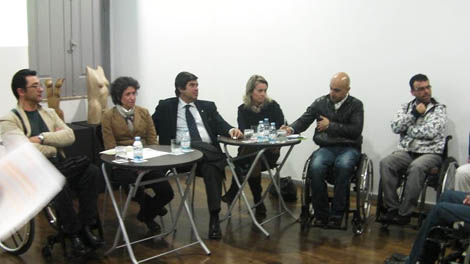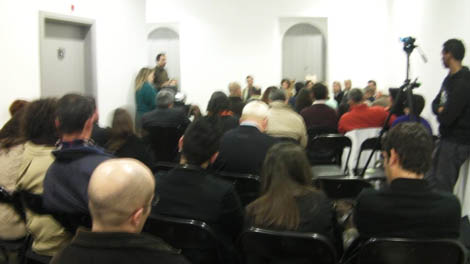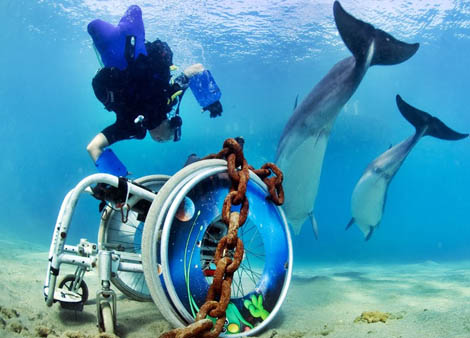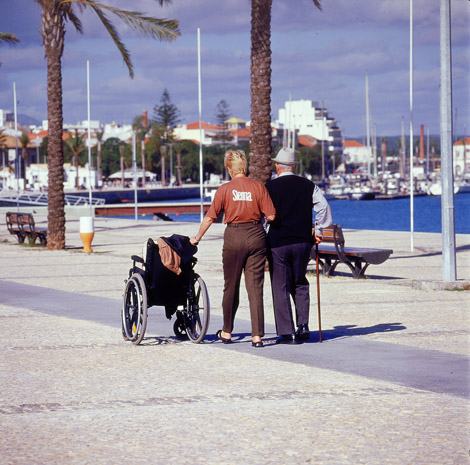 In the Sports Pavilion of the EB 2,3 School in Mexilhoeira Grande, where the adapted Parasport basketball team trains, a metal fence prevents access between the compartment where the sports wheelchairs are stored and the game area.
In the Sports Pavilion of the EB 2,3 School in Mexilhoeira Grande, where the adapted Parasport basketball team trains, a metal fence prevents access between the compartment where the sports wheelchairs are stored and the game area.
Result: he is one of the athletes, who despite everything is easier to move around, who, every time there is training, has to make the extra effort of picking up the chairs one by one and placing them inside the enclosure gameplay (see video at the end of this article).
This example was presented on Wednesday night in another debate of the cycle “Teia d'Ideias”, on the theme “Mobility vs Accessibility – the vision of those who need it”, an initiative of the association Teia d'Impulsos, which took place in Manuel Teixeira Gomes House, in downtown Portimão.
Guilherme Ribeiro, member of Web of Impulses and he himself has a physical disability, he intended to show how a recent building, with good external access, ends up presenting architectural barriers in which those who do not have mobility problems do not even notice.
Councilwoman Isabel Guerreiro, present at the debate, confessed that she herself had never noticed this detail and promised to try to change the situation.
 Another example: at the CTT station in Largo Teixeira Gomes there is an external elevator to facilitate access for people with physical disabilities, namely those traveling in wheelchairs. But to activate this platform it is necessary to ring a bell, which has to alert an employee inside the post office. It turns out that the doorbell, perhaps because it is exposed outside, is almost always out of order...
Another example: at the CTT station in Largo Teixeira Gomes there is an external elevator to facilitate access for people with physical disabilities, namely those traveling in wheelchairs. But to activate this platform it is necessary to ring a bell, which has to alert an employee inside the post office. It turns out that the doorbell, perhaps because it is exposed outside, is almost always out of order...
Nuno Silva, moderator of the debate, put into words what a large part of the audience was thinking: “I had never noticed that there was a bell there. The more it was broken»…
João Nunes, delegate of the Portuguese Association for the Disabled, gave other examples: at Praia da Rocha, on the access to the beach, recently completed, «there is only one handrail on the right where I can grab onto it, to go down. And to go up? Do I come from behind? And on the Vai e Vem buses, there is only one ramp for the disabled at Largo do Dique. I go up here and go down where?».
Despite these examples, Portimão is even the city in the Algarve best prepared for accessibility and mobility.
For now, stressed Paula Teles, national coordinator of the Network of Cities and Towns with Mobility for All, Portimão has the 1st and only Accessible Route in Portugal and one of the few in Europe.
So far, noted the expert, across the country there have been 80 Municipal Councils that have joined the Network project, and the Algarve is the region where the largest number of municipalities have joined, because "it realized that accessibility was very important in its touristic projection" .
An adhesion that Paula Teles praised, since, she said, "making ramps, covering the hole in the sidewalk, taking the garbage out of the way is not the type of project that gives much visibility to the action of local authorities."
A municipality stops the Strategic Plan for Accessible Tourism in the Algarve
 António Almeida Pires, vice-president of the Regional Tourism Authority of the Algarve responsible for Accessible and Senior Tourism, among others, pointed out that 10% of the world's population has some kind of disability and that this number rises to 40% if you think about it. for all people with special needs, such as the elderly, pregnant women, families with prams.
António Almeida Pires, vice-president of the Regional Tourism Authority of the Algarve responsible for Accessible and Senior Tourism, among others, pointed out that 10% of the world's population has some kind of disability and that this number rises to 40% if you think about it. for all people with special needs, such as the elderly, pregnant women, families with prams.
In Europe, he added Almeida Pires, there are 134 million people potentially “consumers” of adapted tourism.
Realizing the «window of opportunity» that Accessible Tourism can be for the Algarve, ERTA decided to move towards a Strategic Plan, which would also involve the 16 municipalities in the region. But there was a City Council – whose name Almeida Pires did not want to reveal – that refused to participate in the Strategic Plan and, therefore, this instrument will no longer go forward. “The local authority that was left out did so not for lack of money, but for lack of vision”, guaranteed the vice-president of ERTA.
With the failure of the strategy that Turismo do Algarve intended to launch at a regional level, Almeida Pires, in a personal capacity and because he has been deeply committed to these issues, launched a public petition, for which it expects to receive 5000 signatures, so that the subject is necessarily discussed in the Assembly of the Republic. For now, it's just over 600 signatures…
Regarding the importance of accessibility to attract tourists, Paula Teles stressed that, in the Algarve, «it cannot be only Portimão that is accessible, it is necessary that all other cities are accessible». Because, explained the expert, “tourists don't want to stay only inside the resort, which can even be accessible. They want to walk, visit the market, visit the center, go to Lagos tomorrow and the next day to Tavira».
«This is a market cluster that will only be strong and assert itself when all municipalities are equally strong» in terms of accessibility. «The Algarve must go hand in hand to eliminate barriers and be a center of attraction for these special tourists», who are more and more.
But it is not just in terms of tourism that there is a lot of work to be done. Célia Sabino, a social worker at the Centro Hospitalar do Barlavento Algarvio, in Portimão, who works precisely with people with disabilities, revealed that she is part of a working group created within the scope of the Regional Health Administration (ARS) to eliminate architectural barriers in structures linked to the ARS.
The works are now in the diagnostic phase, and then move on to assessing the costs of the necessary interventions. «But we are talking about buildings of all types, some of them very old, which date back to the beginning of the National Health Service, after the April 25. But whether the accessibility inside or outside the buildings, everything is being discussed at the moment».
Five kilometers with video camera in wheelchair
 An evaluation was also what made the association Web of Impulses, in the preparation of this debate. “I surveyed the entire city and went as far as the city let me go,” explained Guilherme Ribeiro.
An evaluation was also what made the association Web of Impulses, in the preparation of this debate. “I surveyed the entire city and went as far as the city let me go,” explained Guilherme Ribeiro.
In addition to an exhaustive photographic survey of the good and bad points of accessibility in public buildings and on the streets of Portimão, Guilherme also took the trouble to cover the five kilometers of the Accessible Route, with a video camera attached to his wheelchair. . “Supposedly the Accessible Route is an uninterrupted and barrier-free route, but that's not true,” he guaranteed.
And he demonstrated it, showing some images from that video, which will soon be available on Youtube: the Social Security building, which itself has excellent accessibility, is not easily connected to the Accessible Route. For those who have no problems getting around, access looks great. But the images taken from Guilherme's wheelchair show that reality is different.
In other words, despite all the investments made in Portimão, the conclusion of the debate, which lasted almost until 1:00 am, is that, as the specialist Paula Teles said, accessibility is «a process that is never finished».
Portimão buildings with good e has accessibility
(according to the survey made by Teia d'Impulsos)
>>>Municipal library - Excellent accessibility
>>>Job Center - non-accessible building
(there is a step at the entrance; it was solved with the construction of a small ramp)
>>>Registry and Notary – not accessible
(steps at entrance)
>>>CTT Largo Gil Eanes – not accessible
(step at the entrance)
>>>CTT Largo Teixeira Gomes – accessible, but not always
(if the bell is broken…)
>>>EMRP – Excellent accessibility
>>>Finance – not accessible
(the building itself looks accessible, but the inland parking lot and unfinished sidewalks impede access)
>>>Portimão Parish Council – accessible only to a few
(very steep entrance ramp)
>>>PSP - not accessible
(has a non-regulatory and dangerous ramp)
>>>Social Security - Excellent accessibility
(three-level ramp, easy to use)
>>>Court - accessible only to a few
(non-regulated threshold stone about 4 cm high; it was solved by rounding the stone)
subscribe here to Public Petition «Accessible Tourism – All Different, All Equal»
Another debate in perspective:
This initiative by Teia D'Impulsos had the support of Pastelaria Arade and Delta, which sweetened the break in this gathering.
As usual, the debate was recorded in audio format, and later broadcast, in deferred, by Rádio Costa D'Oiro in the program “Impulso”, in its editions of 8 and 15 March, between 20 and 22:00.
The 7th episode of Teia d'Ideias is already scheduled, which will take place on April 11th and will be under the theme “Portimão – Seen by outsiders”.
More information about this and other initiatives of the Teia D'Impulsos Association at www.teiadimpulsos.pt or through the e-mail [email protected].


















Comments